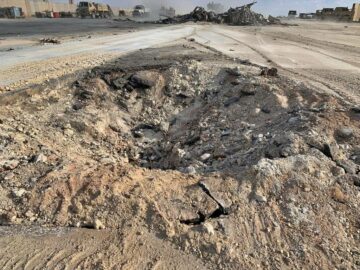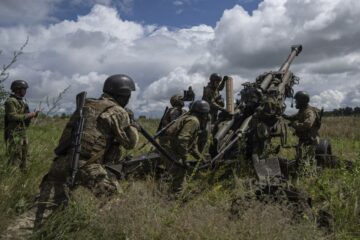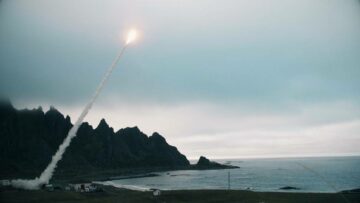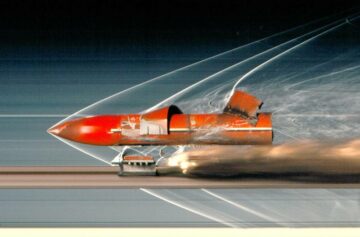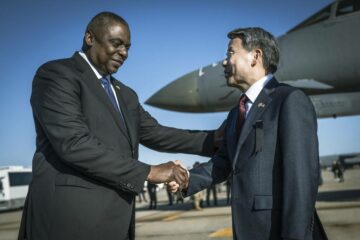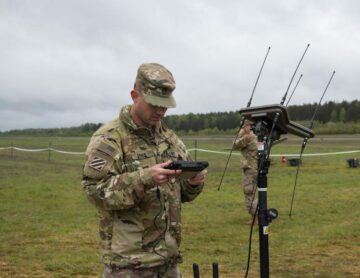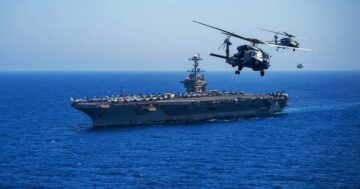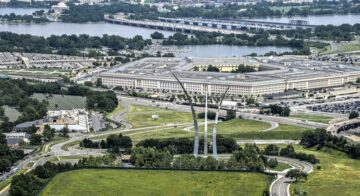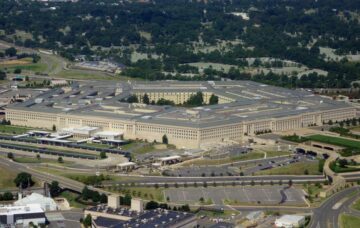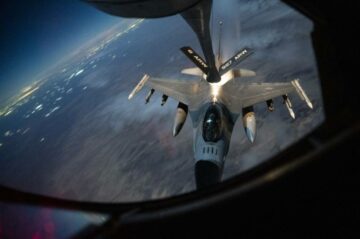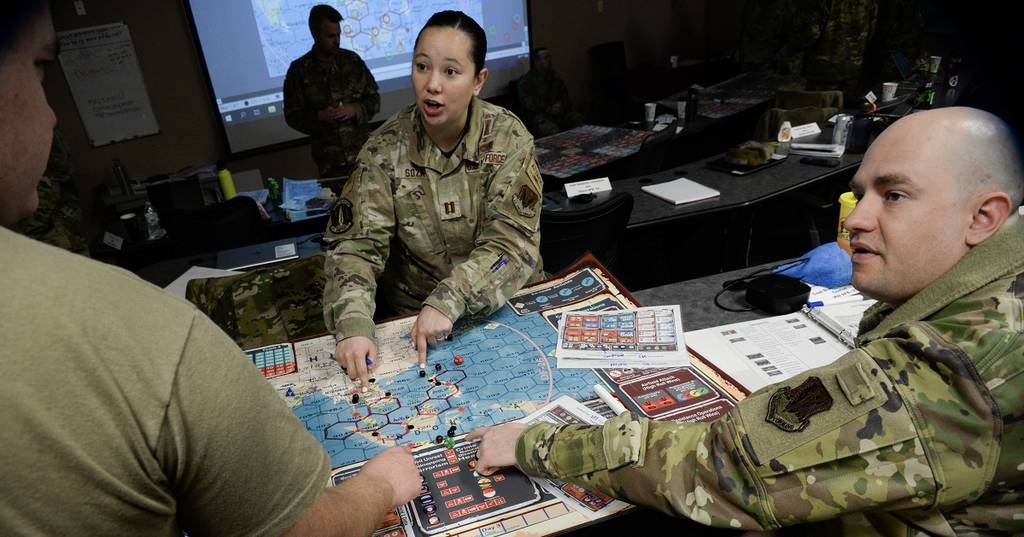
“Every time I pass a bulldozer, I want to stop and kiss it,” said Adm. William Halsey, the commander of the South Pacific in 1945. He had lived the adage that logistics wins wars, overcoming the four tyrannies of distance, water, time, and scale, on the way to victory.
The Indo-Pacific remains an unforgiving theater of operations to this day, and, when combined, the four tyrannies interact to undermine U.S. deterrence against China—most notably, the deterrent effect of airpower. Pentagon planners need to understand this interactive effect and seek solutions that address the entire problem, not just each individual component.
First, the “tyranny of distance” works against U.S. deterrence in the Indo-Pacific. The continental United States stands twice the distance from bases in the Indo-Pacific as it is from those in Europe. This distance extends supply lines, resulting in a larger portion of the force being allocated to support functions (“tail”) rather than combat roles (“tooth”). In contrast, China’s closer proximity to the combat zone simplifies its logistics, allowing it to rapidly concentrate combat power. This asymmetry favors Beijing to the detriment of U.S. deterrence.
Second, the vast Pacific Ocean – or the “tyranny of water” – not only increases the distances that U.S. aircraft and naval vessels must close to put their weapons within range of targets, it also severely constrains basing options. Short-legged fighter jets lack the necessary fuel to complete missions in the Taiwan Strait, for example, and return to limited bases in the region. In-flight refueling would extend their operational ranges, but tankers make attractive targets for Chinese missiles.
As a result, the U.S. Air Force finds itself in danger of not being able to generate sufficient sorties to deny a Chinese victory. In pushing tankers back, the People’s Liberation Army could achieve air denial, and possibly even air superiority, without ever defeating U.S. air superiority fighters in combat. Given that achieving air superiority is critical to Beijing’s theory of victory, especially in a Taiwan scenario, the constraints of maritime geography, as well as Chinese missile threats, substantially weaken U.S. deterrence.
Third, successful extended deterrence depends on rapidly projecting massive combat power into the region. But U.S. forces and capabilities will not matter if they arrive too late to the fight. This is the “tyranny of time.” U.S. warplanes can fly across the Pacific from the West Coast in a matter of hours, but they require tanker support along the route, adding 24 to 48 hours of lead time.
Moreover, it would take months to deploy large numbers of U.S. forces and weapons into the theater. Before the 2003 invasion of Iraq, even with a continuous presence in the Middle East, and no enemy interference, it still took six months to build up U.S. personnel and the “iron mountain” of materiel required to support initial combat operations. More fundamentally, time was on the United States’ side. The United States held the initiative, commencing military operations at the time and place of its own choosing. In the Indo-Pacific, China would most likely hold this advantage.
Finally, in the event of a conflict with China, U.S. logistics operations would be staggering in scale and complexity. The “tyranny of scale” is not linear — there is not a one-to-one correspondence between additional “tooth” and “tail.” Limited ramp space, for example, would require military planners to employ aircraft from more operating bases, which would increase both aerial-refueling requirements and on-the-ground sustainment needs (e.g., maintenance and servicing, support facilities, and weapons storage sites, etc.).
The planning and execution of logistics operations at scale is no easy task. Even with months of careful planning, the July exercise Mobility Guardian 23 encountered complications. For example, one C-17 aircraft only made it to Hawaii because of mechanical issues, while others fell behind schedule at various points. These incidents are all manageable in isolation, but they compound one another to quickly have a cascading effect.
Of course, Beijing is planning to make it a whole lot worse. The real danger is that Chinese leaders calculate a window exists for them to achieve a fait accompli before the United States has sufficient combat power in the region. The ability to mobilize, deploy, and sustain the U.S. military is thus key to effective deterrence.
Unfortunately, the logistics problem defies simple solution, complicated by the fact that solving one tyranny often makes the others worse. For example, the United States could deploy more forces forward to try to address the tyrannies of distance and time. Without additional basing options, however, these forces would end up concentrated at large bases and vulnerable to an adversary’s first strike. To mitigate this threat, the United States could try to distribute its forces more widely within the first island chain, but a distributed force posture exacerbates the challenges of operating across large swaths of water and increases the complexity and scale of logistics and sustainment.
Instead of trying to solve each part of the logistics problem independently, the Pentagon should develop an integrated approach to cope with the four tyrannies simultaneously. Doing so requires new ways of thinking, along with making hard choices and accepting risks that the individual military branches would prefer to avoid. There are no silver bullets to make the logistics and sustainment that underwrite U.S. deterrence in the Indo-Pacific any easier, faster, or more efficient and effective.
Col. Maximilian K. Bremer, U.S. Air Force, is the director of the Special Programs Division at Air Mobility Command.
Kelly Grieco is a senior fellow with the Reimagining U.S. Grand Strategy Program at the Stimson Center, an adjunct professor of security studies at Georgetown University, and a nonresident fellow at the Brute Krulak Center of the Marine Corps University.
This commentary does not necessarily reflect the views of the U.S. Defense Department, the U.S. Air Force, the U.S. Marine Corps, or Marine Corps University.
- SEO Powered Content & PR Distribution. Get Amplified Today.
- PlatoData.Network Vertical Generative Ai. Empower Yourself. Access Here.
- PlatoAiStream. Web3 Intelligence. Knowledge Amplified. Access Here.
- PlatoESG. Carbon, CleanTech, Energy, Environment, Solar, Waste Management. Access Here.
- PlatoHealth. Biotech and Clinical Trials Intelligence. Access Here.
- Source: https://www.defensenews.com/opinion/2023/12/04/the-pentagon-needs-fresh-ideas-for-evading-taiwan-logistics-pitfalls/
- :has
- :is
- :not
- $UP
- 23
- 24
- 70
- a
- ability
- Able
- accepting
- Achieve
- achieving
- across
- adding
- Additional
- address
- adjunct
- ADvantage
- against
- AIR
- Air Force
- aircraft
- All
- allocated
- Allowing
- along
- also
- an
- and
- Another
- any
- approach
- ARE
- Army
- AS
- At
- attractive
- avoid
- back
- BE
- because
- before
- behind
- Beijing
- being
- between
- both
- branches
- build
- but
- by
- calculate
- CAN
- capabilities
- careful
- Center
- chain
- challenges
- China
- Chinas
- chinese
- choices
- choosing
- Close
- closer
- Coast
- combat
- combined
- commencing
- Commentary
- complete
- complexity
- complicated
- complications
- component
- Compound
- concentrate
- Concentrated
- conflict
- constraints
- continental
- continuous
- contrast
- could
- course
- critical
- DANGER
- day
- defeating
- Defense
- Defense Department
- Department
- depends
- deploy
- deterrent
- develop
- Director
- distance
- distribute
- distributed
- Division
- does
- doing
- e
- each
- easier
- East
- easy
- effect
- Effective
- efficient
- end
- Entire
- especially
- etc
- Europe
- Even
- Event
- EVER
- example
- execution
- Exercise
- exists
- extend
- extends
- facilities
- fact
- faster
- favors
- fellow
- fight
- fighters
- finds
- First
- For
- Force
- Forces
- Forward
- four
- fresh
- from
- Fuel
- functions
- fundamentally
- generate
- geography
- georgetown
- given
- grand
- guardian
- had
- Hard
- Have
- hawaii
- he
- Held
- hold
- HOURS
- However
- HTTPS
- i
- ideas
- if
- images
- in
- incidents
- Increase
- Increases
- independently
- individual
- initial
- Initiative
- integrated
- interact
- interactive
- interference
- into
- invasion
- iraq
- island
- isolation
- issues
- IT
- ITS
- itself
- Jets
- jpg
- July
- just
- Key
- kiss
- Lack
- large
- larger
- Late
- lead
- leaders
- liberation
- likely
- Limited
- lines
- logistics
- Lot
- made
- maintenance
- make
- MAKES
- Making
- manageable
- Marine
- Maritime
- massive
- Matter
- mechanical
- Middle
- Middle East
- Military
- missiles
- missions
- Mitigate
- mobility
- months
- more
- more efficient
- most
- must
- necessarily
- necessary
- Need
- needs
- New
- no
- notably
- numbers
- ocean
- of
- often
- on
- ONE
- only
- operating
- operational
- Operations
- Options
- or
- Others
- overcoming
- own
- Pacific
- Pacific Ocean
- part
- pass
- pentagon
- people’s
- Personnel
- Place
- planning
- plato
- Plato Data Intelligence
- PlatoData
- points
- portion
- possibly
- power
- prefer
- presence
- Problem
- Professor
- Program
- Programs
- Pushing
- put
- quickly
- Ramp
- range
- ranges
- rapidly
- rather
- real
- reflect
- Refueling
- region
- reimagining
- remains
- require
- required
- Requirements
- requires
- result
- resulting
- return
- risks
- roles
- Route
- s
- Said
- Scale
- scenario
- schedule
- security
- Seek
- senior
- servicing
- severely
- should
- side
- Silver
- Simple
- simplifies
- simultaneously
- Sites
- SIX
- Six months
- So
- solution
- Solutions
- SOLVE
- Solving
- South
- Space
- special
- staggering
- stands
- States
- Still
- Stop
- storage
- Strategy
- strike
- studies
- substantially
- successful
- sufficient
- supply
- support
- Taiwan
- Take
- targets
- Task
- than
- that
- The
- The Initiative
- The West
- Theater
- their
- Them
- theory
- There.
- These
- they
- Thinking
- this
- those
- threat
- threats
- Thus
- time
- to
- too
- took
- try
- trying
- Twice
- Tyranny
- u.s.
- U.S. Air Force
- understand
- United
- United States
- university
- various
- Vast
- vessels
- victory
- views
- Vulnerable
- want
- Warplanes
- was
- Water
- Way..
- ways
- Weapons
- WELL
- West
- when
- which
- while
- whole
- widely
- will
- william
- window
- Wins
- with
- within
- without
- works
- worse
- would
- zephyrnet

